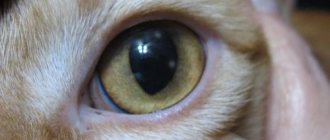Parasites in the body of cats distributed everywhere. Based on the nature of their location, they can all be divided into external, that is, living on the surface of the cat’s body, and internal, that is, parasitic inside the body. All of them, without exception, lead to serious pathologies, and some of them can even be transmitted to humans. That is why it is so important to identify and destroy them in time.
External parasites
External parasites are called ectoparasites. These are ticks and fleas well known to many cat owners.
Fleas
Fleas easily cling to shoes and clothes, enter the apartment from the street and through communication pipes. They live in a cat's fur, feed on its blood and often cause dermatitis.
Ticks
Ear and ixodid ticks. Ear mites penetrate through contaminated objects, and also appear in cats upon contact with a sick animal. The parasite itself lives in the ear canal. Ixodid ticks live in a free environment and become active from the first warming to frost. They attack the animal and feed on its blood.
Sarcoptic mange and notoedrosis. Micromites are transmitted from cat to cat, or the cat becomes infected from the place where the sick cat lay. Both diseases are accompanied by itching in the ears, head, neck, and chest. Areas without hair appear that the cat painfully combs. Mites penetrate the epidermal layer and multiply rapidly.
Diseases are treated with acaricidal drugs: Advocate, Selamectin. For diagnosis, a deep scraping is taken. In addition to treating the cat, it is necessary to carry out hygiene of the places where it usually stays. Special means are used for this.
Lice
Lice often appear at the same time as fleas, but they can also infect your pet on their own. Lice feed on particles of his skin and fur, get on them through clothes and shoes, through contact with sick animals, when walking a pet on the stairs or the street.
If you find parasites on an animal, then the cat bed needs to be washed at high temperature or disinfected.
Can human lice live on cats?
No, this is impossible. Despite the external similarity, these are different lice. Parasites do not spread from humans to cats. And even if you specifically introduce lice from a person to a cat, they will not be able to live there.
Causes:
- Body temperature difference. The body temperature of cats and dogs is higher than that of humans. This environment is unfavorable for lice and they die.
- In addition, the structure of the hair is different. Accordingly, the structure and structure of the legs of insects is different. Human lice simply cannot cling to cat hairs with their paws. And they need exclusively human blood.
Can human lice live on cats?
Internal parasites
The most common parasites in domestic animals are helminths. As a rule, these are intestinal endoparasites. Not only worms, but also their larvae parasitize inside the cat’s body. With some helminthiases this is dangerous for humans. Habitats: water, soil, meat and fish without veterinary sanitary and medical examination, poorly washed vegetables and fruits, water, grass.
Mechanism of infection:
- Through the digestive tract when eating infected fish or meat.
- Through intermediate hosts (fleas, rodents, fish, crustaceans).
- Raw water.
- Through feces. The cat licks them off its paws. Helminth larvae come with the dirt.
- Through skin pores into the bloodstream.
- From a mother cat to a kitten.
The routes of infection depend strictly on the type of helminthiasis.
Helminths
Protozoan unicellular parasites (giardia, coccidia)
They are not classified as helminths as such. Giardia affects cats, dogs, rodents, birds, and people. Its main feature is a suction disk on the surface of the body. With its help, it attaches to the microvilli of the small intestine and feeds on digested food.
The second form of existence of Giardia is cysts. This protective shell makes Giardia more resistant to low temperatures, but it dies at high temperatures and boiling. A cat becomes infected through the fecal-oral route, through contaminated water and food. At risk are walking cats, cats with suppressed immune systems, and individuals living in nurseries and shelters.
Symptoms are usually erased, sometimes manifesting themselves in the form of intestinal disorders, diarrhea, and general malaise.
Parasites are found in feces through scatological analysis. It is necessary to make several samples over several days. Giardiasis is treated with special antibiotics for 7–10 days with repeated testing.
Tapeworms (cystodes)
They can reach 1.5 m in length. A cat becomes infected with them when it eats a mouse, rat, fish or insects. Their representatives are cucumber tapeworms and lancetids. Typically, these parasites settle in cats' lungs or intestines. They cause diseases such as dipylidia and diphyllobothriasis.
Roundworms (nematodes)
These are small helminths ranging in length from a few mm to 40 cm. Most often, cats suffer from roundworms. They enter the animal in the form of larvae from the ground or sand, through raw meat products, fish, or an infected rodent.
The most common method of infection is through fleas. Often the owner himself infects a cat with worms if he does not wash his hands after using the toilet and touches its nose afterwards. Roundworms cause toxocariasis, enterobiasis, and hookworm.
Flukes (trematodes)
They affect the liver, bile ducts, and pancreas. The main source of infection is raw fish. Flukes cause the diseases opisthorchiasis and paragonimiasis .
Many of these parasites are moisture resistant and survive excellently in any environment.
Infection from a mosquito bite: dirofilariasis
Dirofilariasis affects the subcutaneous tissue and eyes. A cat becomes infected from an infected mosquito that feeds on its blood. Many larvae die in its body due to its good resistance to dirofilariasis. This disease is 10 times less common than in dogs.
Symptoms of dirofilariasis are as follows:
- lethargy,
- excessive fatigue
- refusal to eat.
The disease has acute and chronic forms. When the heart is affected, the course of the disease in cats is more severe than in dogs and is often fatal. In the cardiac form, a dry cough, shortness of breath, murmurs, irregular heart rhythm, and swelling are typical.
In the subcutaneous form, mobile tumor-like formations, itching, ulcers, and hair loss appear.
When the organs of vision are affected, lacrimation begins, redness of the mucous membranes begins, and the eyelids swell, which can completely close the eyes. The parasite is localized in the eyeball.
Diagnosis of the disease in cats is more difficult than in dogs. The doctor takes tests for microfilariae in the blood, but this method is not very informative. He also tests for antibodies, but even if microfilaria is present, the result is negative. Serological tests and echocardiography are also used. Treatment of dirofilariasis is carried out with specific drugs. Essential medications are focused on treating dogs.
Cats that walk outside unattended are at risk of becoming infected with parasites.
Pathogens
Dogs are most often parasitized by canine, cat and human fleas. Adult insects are wingless, the body is strongly compressed laterally, the legs are strong, long, with numerous spines, the antennae are short, club-shaped, hidden at rest in recesses on the sides of the head. The mouthparts are adapted for piercing the skin and sucking blood. Fleas are small insects with a body usually not exceeding 2-4 mm in length.
The pathogen has ctenidia on the lower edge of the head and on the posterior edge of the anterior thoracic segment (a row of spines in the form of a comb-like formation with points directed backwards), consisting of 7-9 spines, with the first spine in the head row and the lower spine in the thoracic row of the ctenidium being shorter than the others .
Biology
Fleas are temporary parasites. Female fleas lay very small, oval, whitish eggs, dropping them (non-sticky eggs) onto the host, from where they can roll onto the litter, ground, or floor. After 1-2 weeks, under favorable conditions, larvae with a thin worm-like body emerge from the eggs, leading a free lifestyle and feeding on decaying organic matter and food residues. After a few days, the larvae pupate in a cocoon. After 12 days, an adult flea emerges from the pupa, leading a parasitic lifestyle.
Males and females suck blood. Capable of long-term fasting (up to 18 months) outside the host’s body.
Symptoms of infection
If you notice several alarming signs of parasites in your cat, do not delay visiting a veterinarian for treatment.
- The cat feels general malaise, becomes lethargic and indifferent, and loses weight.
- She drinks a lot, refuses food or, on the contrary, eats greedily.
- The animal constantly itches, bites into bite sites, rubs against legs and furniture, and sleeps poorly.
- The coat becomes dull, dry, and begins to fall out. Bleeding scratches and wounds are visible on the skin.
- The mucous membranes and gums look pale, the eyes become dull.
- The cat begins to cough heavily.
- The pet notices small rashes, redness and swelling around the anus.
- He suffers from bloating, vomiting or diarrhea (sometimes with blood).
- Helminths and their larvae are visible in vomit and feces. The stool itself changes texture and color.
Can lice pass from a cat to a person?
No, insects from a cat's fur do not pass on to humans. This is due to the structural features of insects. A person's body temperature is lower, so even if several parasites are specially transferred, they will not be able to live on a person's head.
Can lice pass from a cat to a person?
Diagnosis and treatment
It is not recommended to treat your cat yourself. Sometimes the symptoms of helminthic infestation resemble signs of viral or infectious diseases. The final diagnosis can only be made by a veterinarian. He takes a scatological analysis, makes recommendations and prescribes medications with targeted or complex action. Sometimes the doctor takes vomit for examination, and the diagnosis itself is made in a short time.
Gentle medications are available for kittens that do not harm their stomach. The veterinarian prescribes the optimal dose and regimen for their use.
Symptoms of helminthic infestation are similar to those of other diseases, so it is better to treat the animal by a veterinarian.
Prevention
Regular preventive measures can protect your pet from fleas, lice, ticks, and helminths. Special means have been developed to combat parasites in cats. These are polyvalent drugs: anticystoid, antinematode, antirheumatoid.
A broad-spectrum drug may contain several active ingredients. They act on various types of helminths. These include milbemax, drontal, canikquantel, and prazicide. Each drug affects the cat’s body in its own way. Some destroy the shell of the parasite, others paralyze its nervous system, and others disrupt the metabolism of the helminth. The correct dosage must be observed depending on the weight of the cat.
Even if your cat does not show obvious signs of worm infection, do not neglect regular deworming. Poisoning parasites does not mean poisoning your pet - the procedure is absolutely safe and does not have a toxic effect on the body. In case of mild infestation, anti-parasite drops for cats are used on the withers. They are quickly absorbed into the skin, enter the bloodstream and destroy fleas and worms.
Veterinarians recommend using drugs for internal use against intestinal parasites. To prevent all helminthic infestations, it is enough to treat the cat once every 3 months.
Also, to reduce the risk of infection, do not forget about the following measures:
- Once a week, wet clean the apartment.
- Wipe your shoes after going outside and store them out of reach of your cat.
- Feed your pet high-quality food and heat-treat fish or meat.
- Keep your cat's bowls and litter box clean.
- Do not allow your pet to contact street animals.
- Treat cats that go outside for fleas.
- Hang mosquito nets on windows.
Prevent worms in cats two weeks before breeding and vaccination. Before it, it is recommended to undergo a scatological test for the presence of helminths in fecal matter.
Possible complications in the absence of prevention and treatment
- Fleas provoke skin inflammation because they feed on animal skin flakes and blood. Ticks, fleas and mosquitoes are the source of a vector-borne infection called infectious anemia (hemobartonellosis). Its causative agent is hemobartonella. It becomes more active in the spring and summer due to insect vectors. Animals experience anxiety, pain, and blood loss is life-threatening.
- Helminths affect the cat's immune status. She can get pneumonia, sepsis, and get toxic liver damage.
- A sick pet can infect other animals living in the house, small children and adults.
Monitor your pet’s behavior and do not let the situation take its course if you suspect an infection. Timely prevention is a guarantee of the cat’s health and well-being.
Background. Who are ectoparasites
From an encyclopedic point of view, ectoparasites are insects that parasitize the body of mammals (from the Greek: external + parasite). Insects can parasitize temporarily or permanently; they have various organs for attachment to the “host” body - suction cups, claws on their paws, hooks, etc.
From an entomological point of view, these are parasites: blood-sucking, arthropods, piercing-sucking and others.
Typical representatives of the group are fleas, lice eaters and other arthropods of the Arthropoda type, arachnids (ixodid and other ticks).
Ectoparasites have a detrimental effect on the health and well-being of pets, dogs and cats, and become carriers of diseases.
The clinical picture of the invasion is scratching and itching, crusts, scabs on the skin; in advanced cases, alopecia, boils, erythema, and tissue necrosis are possible.
Arthropod ectoparasites of dogs and cats cause otodecosis, demodicosis, notoedrosis, cheyletiosis - invasive diseases that are caused by various types of ticks and fleas.











